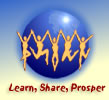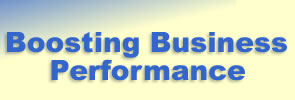 |
|
August 2016
Volume 12, Issue 8
These are free monthly tips on boosting
business and professional results.
Start your subscription!
To change subscription options, please
see the bottom of the page.
 Like us on Facebook! Like us on Facebook!
|
|
Greetings!
Below find this month’s newsletter, hot off the press!
- Special Message: Get Rid of Obstacles in Your Personal and Professional Life
- Feature Article: What’s Holding You Back?
Tips on Managing Your Biggest Constraints
Please add “Adele@LearnShareProsper.com” to your whitelist or address book in your e-mail program,
so that you have no trouble receiving future issues.
You subscribed to this newsletter at LearnShareProsper.com. You’re very welcome to forward it to your
colleagues; please just keep the entire message intact.
If you wish to discontinue your subscription, please
use the links at the bottom.
|
|
 |
|
Is Your Task List Turning into a Tug-of-War?
My last several newsletters delved into a variety of ways to become “unstuck,” overcome overload, pursue our professional passions in life, and otherwise create the conditions for our success. Carrying this theme a bit further, I thought I would focus on ways to cut through constraints that can reduce our productivity.
Whenever I talk about productivity, though, many people think I’m referring to what efficiency experts do. So, what does an efficiency expert do, and what is the difference between boosting efficiency and working with and around the kinds of obstacles that I’m referring to? Let me explain...
 Efficiency experts get things done with less time and effort. They use time-saving tools, techniques, devices, and software to trim, condense, eliminate, combine, or otherwise shortcut our laborious, tedious, and extremely time-consuming tasks. Efficiency experts get things done with less time and effort. They use time-saving tools, techniques, devices, and software to trim, condense, eliminate, combine, or otherwise shortcut our laborious, tedious, and extremely time-consuming tasks.
They also know how to organize files, desks, computers, and electronic gizmos. They help people split up their schedules so they can arrange them into highly productive blocks.
Although I greatly value this domain of professional expertise, I prefer to aim my efforts in slightly different directions. Like efficiency experts, I hunt for things that impede accomplishment. But the impediments I pursue are not typically those that resolve easily by speeding up work, reducing keystrokes, or organizing space and time more creatively. They tend to be more complex and multidimensional.
One of those areas is system constraints. They handcuff our productive capacity and tend to elude our ability to control them. That’s why today’s newsletter delves more deeply into this type of road block, and introduces a field of study called the Theory of Constraints. Below, you’ll see tips, books, and resources for managing constraints at the system level, as well as working with those under your personal control.
I hope you enjoy this month’s features, and please be sure to share your thoughts by leaving your comments on my Facebook page!
Here’s to your business prosperity,

Adele Sommers, Ph.D., business improvement specialist, author, educator, and award-winning instructional designer
P.S. If you missed any previous issue, please visit
the newsletter archive!
|
|

|
|
Get Rid of Obstacles in Your Personal and Professional Life
Have you ever felt the effects of subtle and not-so-subtle blockades that are keeping you from accomplishing everything that’s possible in your personal and professional life? For example...
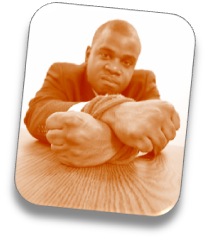 Have you ever wondered whether obstacles you’ve been experiencing might be occurring from insufficient knowledge, aptitude, energy, talent, commitment, or resolve? These areas represent aspects of your potential, but they are not necessarily what’s holding you back. Have you ever wondered whether obstacles you’ve been experiencing might be occurring from insufficient knowledge, aptitude, energy, talent, commitment, or resolve? These areas represent aspects of your potential, but they are not necessarily what’s holding you back.
For instance, you might have been pondering whether to attend more classes, invest more time, improve your skill set, or just struggle even more valiantly than you already do. If so, you’ll be glad to know that the answers may be simpler and more precise than the range of possibilities you’ve been considering.
According to business advisor Rich Schefren, our real successes do not relate as much to demonstrating our potential as they do to removing our constraints. Focusing on and removing our constraints (by asking, “What’s holding me back?”) often is more effective than perfecting our potential. Our constraints could be rational, procedural, or self-imposed, such as:
- Linear thinking that prevents us from seeing our organizations as complete systems (rational)
- Bottlenecks in our selling processes that prevent prospective customers from completing purchasing transactions (procedural)
- A fear of making mistakes, even though experimentation is what helps us learn what works and what doesn’t (self-imposed)
Read on for more ways to apply these principles! |
|
 |
What’s Holding You Back?
Tips on Managing Your Biggest Constraints
by Adele Sommers
Is your organization struggling with getting things done, but nothing that you or your colleagues can do seems to increase your overall level of output? If so, this problem may be occurring because of hidden constraints (log jams) in your workflow that are conspiring against completing anything on time.
This article explores ways to identify and manage constraints in manufacturing and project management. To optimize results, you’ll want to start by avoiding any false sense of productivity in your enterprise as a whole. Note that it doesn’t really matter how much each individual department or work group produces; it’s what the entire organization puts out that counts.
Where’s the Bottleneck? Introducing the Theory of Constraints
Dr. Eli Goldratt’s Theory of Constraints (TOC) introduced a new way of analyzing and rethinking the underlying causes of sluggish assembly lines and their related accounting practices in manufacturing firms. The ensuing revelations sparked by TOC principles eventually revolutionized how thousands of organizations viewed and measured productivity.
After achieving remarkable success in the manufacturing arena by turning around failing industries, the uses of TOC have since expanded into project management, software development, marketing, problem solving, and more.
In its simplest mode, TOC entails a set of principles for identifying and managing (or ideally, eliminating) limitations and bottlenecks in any business situation. Handling these snarls effectively can vastly increase the potential for success.
 Examples of bottlenecks in the manufacturing arena include time-intensive assembly processes or specialized pieces of equipment that simply can’t produce more than a certain level of output because of their own volume or speed limitations. Examples of bottlenecks in the manufacturing arena include time-intensive assembly processes or specialized pieces of equipment that simply can’t produce more than a certain level of output because of their own volume or speed limitations.
Superhuman effort cannot shovel the material through the system any faster than the constraints will allow, unless people bypass, work around, or ease each bottleneck’s limitations. For instance:
- On the factory floor, a constraint in an assembly process appears wherever piles of material seem to accumulate problematically at any workstation.
If that station can’t process those batches quickly enough to keep pace with the incoming work, it acts as the “pacing factor” for the entire workflow up to that stage. At that point, the traditional expeditor’s job is usually to bypass the problem by rushing hot work orders around the floor out of sequence. Soon, everything becomes “high priority”!
- In a food preparation facility, constraints might include the oven capacity or the processing equipment. If one limitation is the oven size, for example, no matter how fast the choppers chop or the sauce makers stir, nothing will enable more than a certain number of lasagna dishes to be cooked at one time. And hiring more people to make sauces or noodles will only add to the backlog if the oven capacity doesn’t increase accordingly!
Until someone identifies and resolves these constraints, the whole system remains at their mercy. Frantically expediting work around the bottlenecks makes accurate scheduling impossible. It also creates a chaotic and unpredictable stream of output. So, realize that these are system problems that management must resolve, as they’re usually outside the control of individual workers.
The good news is that you can optimize the workflow to make the constraint areas the stars of the show. In so doing, you can better schedule — and therefore, predict — the speed and output of the workflow. For example, you could consider whether to:
 Increase the capacity of the bottleneck by replacing or retrofitting the slower equipment with faster, more efficient, or larger-sized models. Increase the capacity of the bottleneck by replacing or retrofitting the slower equipment with faster, more efficient, or larger-sized models.
- Buy, borrow, or rent similar, low-capacity equipment and use it in tandem with the existing equipment, which will increase the throughput.
- Schedule additional shifts to run the slower, existing equipment, which would thereby reduce the backlog and keep pace with the incoming material.
- Modify the product designs, streamline the processes, and/or resequence the workflow to either remove or better utilize the bottleneck.
Battling Constraints in Projects
Sometimes, despite our best intentions, we bite off more than we can chew — or we may find that a mundane flow of project activities is suddenly backlogged and threatens to derail our ability to complete the project on time.
If your progress reports show too much work to accomplish in the time available, try to determine where the bottlenecks exist in the planned activity sequence. Whether you discover the blockade through simple observation or sophisticated computer modeling, you can brainstorm a variety of ways to relieve it.
 For instance, you could focus all of your attention on supplying resources to the bottleneck. For instance, you could focus all of your attention on supplying resources to the bottleneck.
Or, you might accelerate the flow of work by relieving some performers of the time-consuming tasks. Consider whether some jobs that generalists perform could occur in “assembly line mode,” where specialists can step in to handle certain things.
For example, let’s say that highly skilled information designers would normally do a large amount of editing and formatting as part of their roles. Yet they easily become bogged down in those painstaking tasks.
So you might investigate whether using specialized editors and formatters could remove that burden from the generalists’ shoulders, which would enable them to concentrate on the remainder of what they do best. Shifting the workload around in this way could reduce pressure, speed up the work, and potentially save the day for the project!
In conclusion, identifying and managing your productivity constraints using TOC principles could produce the “silver bullets” your organization needs to excel. In so doing, you can stop swimming upstream, break through the previous barriers, and experience a gratifying feeling of success!
Copyright 2016 Adele Sommers
|
|
 |
|
Two Great Books on Increasing Throughput
Dr. Eli Goldratt introduced the Theory of Constraints (TOC) thirty years ago, and it has globally transformed the way many businesses operate. Its practical principles have helped companies in numerous ways, such as by increasing their manufacturing output, optimizing business tradeoffs, and clarifying choices in a variety of situations — all by practicing something called managing constraints.
Instead of simply lecturing us on how to apply TOC principles, Goldratt has used fictional storytelling to explain his ideas in riveting and memorable detail. The fascinating plots of his business novels help people assimilate a range of insights and applications through an engaging discovery process. For example, two of his books that I recommend most often are these...
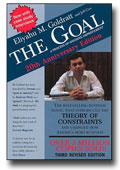 “The Goal,” which was Goldratt’s inaugural business novel in 1984, focuses on the challenges that Alex Rogo, a new plant manager, faces in a highly precarious business predicament. “The Goal,” which was Goldratt’s inaugural business novel in 1984, focuses on the challenges that Alex Rogo, a new plant manager, faces in a highly precarious business predicament.
Since his plant can’t seem to ship any of its products on time, Alex learns that the business will go under unless he figures out what to do. He turns to Jonah, a old consultant friend of his, whose theories and advice help Alex and his colleagues discover and explain the TOC principles that break through the impasse. Many of these discoveries are counterintuitive, which means the dramatic remedies that Jonah prescribes keep Alex and his team constantly on their toes!
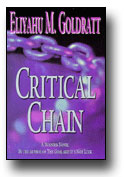 “Critical Chain” next explores TOC in the realm of project management. A business professor and his class of project managers hypothesize, debate, and finally realize why their projects often run late and over budget, or fail to complete everything that was originally specified. “Critical Chain” next explores TOC in the realm of project management. A business professor and his class of project managers hypothesize, debate, and finally realize why their projects often run late and over budget, or fail to complete everything that was originally specified.
As the protagonists examine a range of thorny project issues, we vicariously learn how to optimize a project’s “critical path,” handle resource conflicts, introduce safety buffers, negotiate with subcontractors and suppliers, and predict the effects of early vs. late starts. The resulting formula offers us several powerful ways to resolve these age-old project challenges. |
|
 |
|
Adele Sommers, Ph.D. is the author of “Straight
Talk on Boosting Business Performance” — an award-winning
Special Report and Workbook program.
If you liked today’s issue, you’ll love this down-to-earth
overview of how 12 potent business-boosting strategies
can reenergize the morale and productivity of your enterprise,
tame unruly projects, and attract loyal, satisfied customers.
It’s accompanied by a step-by-step workbook designed
to help you easily create your own success action plan.
Browse the table of contents and reader reviews on the
description page.
Adele also offers no-cost articles and resources to
help small businesses and large organizations accelerate
productivity and increase profitability. Learn more
at LearnShareProsper.com.
LearnShareProsper.com/Business Performance_Inc.,
705 North State Street #187, Ukiah, California,
USA.
For more information, e-mail Info@LearnShareProsper.com. |
|
|
|
| |
|
©2016
Business Performance_Inc., Adele Sommers, All rights
reserved. www.LearnShareProsper.com
Your feedback is always appreciated!
Write to us at info@LearnShareProsper.com.
We respect your privacy and do not give out or sell
subscriber names or e-mail addresses.
Please use the links below to take
yourself off our list or change your e-mail address.
|
|
|
